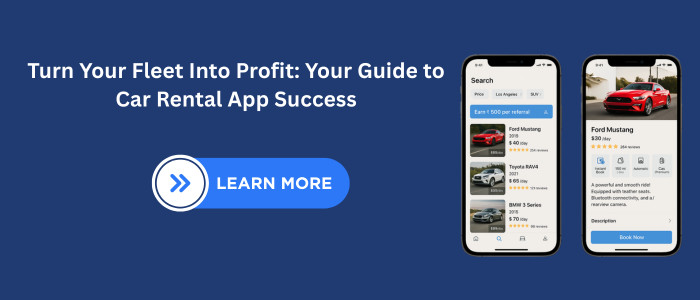The digital transformation in transportation has made it easier than ever for people to rent vehicles on demand. With platforms like Turo taking the lead, entrepreneurs are now exploring how to develop car rental apps like Turo to tap into this booming industry.
Whether you’re a startup or a mobility business, this detailed guide will help you understand every aspect of car rental app creation from concept to launch.
Also Explore how online mobile apps are transforming businesses
Understanding the Turo Model

Turo follows a peer-to-peer (P2P) model that enables car owners to rent their vehicles directly to users via an app. This method provides better flexibility, personalized options, and often lower prices compared to traditional car rental agencies. Turo also ensures secure payments, insurance, and vehicle protection—offering peace of mind to both hosts and renters.
Understanding the inner workings of this system is essential before diving into Turo clone app development. It helps you replicate what’s working while adding your own unique value proposition.
Why Build a Car Rental App Like Turo?

The global car rental market is expected to cross $150 billion in the coming years, and app-based services are a major driver of this growth. People prefer mobile apps for their ease of use, availability, and cost savings. Businesses that develop car rental app like Turo position themselves at the intersection of convenience and profitability.
You get to serve customers seeking alternative mobility solutions while empowering vehicle owners with a passive income stream.
Business Models to Consider

Before diving into development, it’s crucial to select the right business model. This decision shapes your entire roadmap.
- Peer-to-Peer Model: Like Turo, this allows individuals to list and rent out their personal vehicles.
- Aggregator Model: You list fleets from third-party rental agencies.
- Fleet Ownership Model: You manage and rent out a company-owned fleet.
Each model offers different benefits and challenges. Your choice impacts the scope, technical needs, and cost to build Turo-like car rental app systems.
Core Functionalities Your App Must Have

A powerful feature set is the backbone of any car rental app. Here’s what your platform must include:
- User registration and login
- Vehicle browsing and search filters
- Real-time availability calendar
- GPS navigation and vehicle location tracking
- Secure payment gateway
- Ratings, reviews, and history tracking
These elements form the key features of Turo clone app platforms and directly impact user retention and trust.
Check out Cost to Develop an App Like Airbnbs
Tech Stack Recommendations

Your choice of technology stack plays a major role in app performance and scalability. To ensure a smooth experience for users and admins alike, we recommend:
- Frontend: React Native or Flutter
- Backend: Node.js, Django, or Laravel
- Database: PostgreSQL or MongoDB
- Cloud Hosting: AWS, Azure, or Google Cloud
- Payment: Stripe, Razorpay, or PayPal
- APIs: Google Maps for navigation, Twilio for SMS notifications
Choosing the right stack reduces bugs, improves speed, and lowers long-term costs for support.
Explore the best tech stacks for scalable app development
UI/UX Best Practices

Even the most feature-rich app can fail if it’s not intuitive and visually appealing. Prioritize UI/UX from the beginning to drive engagement:
- Simple and intuitive navigation
- Clear CTA buttons for actions like booking, canceling, or uploading
- Minimalistic design with visual cues
- Fast load times and responsive layout
- Accessibility support for users with disabilities
Good design can be your strongest marketing tool and reduce churn drastically.
Need help with UI/UX Let the experts at SDLC Corp turn your idea into a scalable reality
Cost to Build Turo-like Car Rental App

Let’s talk numbers. The cost to build a Turo-like car rental app depends on the scope, complexity, and location of your development team. Here’s a rough breakdown:
| Phase | Estimated Cost (USD) |
|---|---|
| Planning & Research | $2,000 – $5,000 |
| Design (UI/UX) | $3,000 – $8,000 |
| Frontend/Backend Dev | $20,000 – $50,000 |
| Testing & QA | $5,000 – $10,000 |
| Deployment & Support | $5,000 – $15,000 |
| Total Range | $35,000 – $90,000+ |
You can reduce costs by starting with an MVP and iterating based on user feedback.
Monetization Strategies

Your app can generate revenue in several ways:
- Commission Fees: Earn a cut from each rental
- Premium Listings: Car owners can pay to rank higher
- Subscriptions: Offer benefits like early booking access
- In-App Ads: Monetize traffic with ad placements
- Insurance Add-ons: Include protection plans with service fees
Choose models that suit your audience and region. A hybrid model is often the most sustainable.
Legal Compliance and Insurance

To operate legitimately and protect users, you must address legal and insurance needs:
- KYC verification and driver’s license scanning
- Terms of service and liability clauses
- Insurance integration (third-party or in-house)
- GDPR compliance for user data
Legal structure varies by country and region, so consult with a local expert
Marketing and User Acquisition

You need users to succeed, and acquiring them starts with a robust marketing strategy:
- SEO-optimized app listings (App Store & Google Play)
- PPC advertising targeting travel and mobility users
- Email campaigns with referral incentives
- Partnerships with hotels, tour operators, and local businesses
Monitor acquisition costs and lifetime value to optimize your campaigns.
Explore How Can You Maximize ROI with eCommerce Digital Marketing Services
Future Trends and Scalability

To remain competitive, stay ahead of trends shaping the industry:
- AI for predictive pricing and personalization
- IoT for keyless entry and real-time diagnostics
- Blockchain for secure, tamper-proof contracts
- Green Rentals: Add electric vehicle options for eco-conscious users
Design your architecture for scalability from day one.
Read about emerging tech trends in mobile development
Conclusion
The demand for car rental apps is rising, and platforms like Turo have proven that peer-to-peer rentals are the future. With the right strategy, tech stack, and business model, you can develop car rental app like Turo and disrupt the market with your own offering.
This car rental app development guide has walked you through the entire process—from ideation to launch and scaling. Whether you’re aiming for a simple MVP or a fully-loaded platform, understanding the key features of Turo clone app systems and the cost to build Turo-like car rental app infrastructure will help you build effectively and sustainably.
Need help with development?
Let the experts at SDLC Corp turn your idea into a scalable reality. Contact Us at SDLC Corp to kickstart your car rental app today.
FAQs
What Is the Cost to Build a Turo-Like Car Rental App?
The cost to build a Turo-like car rental app ranges from $35,000 to $90,000+, depending on features, complexity, development team location, and tech stack. Starting with an MVP can help reduce upfront investment.
What Are the Key Features of a Turo Clone App?
Key features of Turo clone app platforms include user registration, car listing, real-time booking, GPS tracking, secure payments, reviews, and an admin dashboard for analytics and dispute resolution.
How Long Does It Take to Develop a Car Rental App Like Turo?
Typically, it takes 4 to 6 months to develop car rental app like Turo, from planning to deployment. The timeline can vary based on project scope and whether you’re building from scratch or using a clone script.
How to Start a Car Rental Platform Successfully?
To start a car rental platform, you need to choose a business model, define your audience, integrate the right tech stack, and ensure compliance with legal and insurance requirements. A reliable development partner is crucial to success.
Why Invest in Turo Clone App Development?
Turo clone app development allows you to replicate a proven business model while tailoring it to your niche market. It reduces development time, provides scalability, and helps you enter the booming mobility sector faster.


















